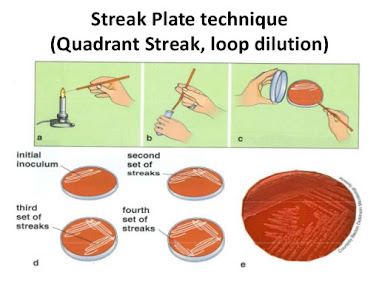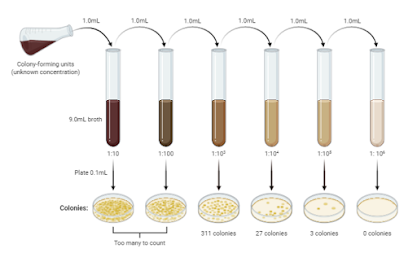Post Views: 80
Obtaining pure culture of microorganism
It involves the common plating techniques employed in microbiology are: –
Streak Plate Method,
Spread Plate Method and
Pour Plate Method.
Streak Plate Method
This method was developed by two bacteriologists, Leoffler and Gaffkey in the laboratory of Robert Koch.
In this method a sterilized inoculating loop or transfer needle is dipped into a suitable diluted suspension of microorganisms which is then streaked on the surface of an already solidified agar plate to make a series of parallel, non-overlapping streaks. The process known as streaking and the plate so prepared is called a streak plate.
The main objective of the streak plate method is to produce well separated colonies of bacteria from concentrated suspensions of cells.
A sterilized inoculating needle with a loop made up of either platinum or nichrome wire is used for streaking.
One loopful of specimen is transferred onto the surface of the agar plate in a sterile petridish and streaked across the surface in the form of a zig-zag line. This process is repeated thrice to streak out the bacteria on the agar plate so that some individual bacteria are separated from each other.
The first streak will contain more organisms than the second and the second more than the third and so on. The last streaks should thin so on. The last streaks should thin out the culture sufficiently to give isolate colonies. The successful isolation depends on spatial separation of single cells.
Each colony usually represents the growth from a single organism when such a plate is incubated colonies will appear on the surface of the medium.
Because of the high concentration of water in agar, some water of condensation forms in petriplate during incubation.
Moisture is likely to drip from the cover to the surface of the agar and spread out, resulting in a confluent mass of growth and running individual colony formation.
To avoid this, petriplates are routinely incubated bottom side up. Pure colonies can be obtained from well isolated colonies by transferring a small portion of each to separate culture media.
Spread Plate Method
The spread plate technique is used for the separation of a dilute, mixed population of the microorganisms so that individual colonies can be isolated. means mixed culture of various microorganism.
In this technique, a small volume (A drop) of dilute microbial mixture is transferred to the center of an agar plate and spread evenly over the surface with a sterile L-shaped bent glass rod, while the petridish is spun, at some stage, single cells will be deposited with the bent glass rod on the agar surface.
As a result of separation of individual microorganism by spreading over the drop of dilution liquid on the medium of the plate.
Incubate the agar plate at 37ºC for 24 hours, in the inverted position. The dispersed cells will develop into isolated colonies.
Because the number of colonies will be equal to the number of viable organisms in the sample spread plates can be used to count the microbial population.
Isolated colonies are picked up and transferred onto fresh medium to ensure pirity
Pour Plate Method
This method involves plating of diluted samples mixed with melted agar medium.
The main principal is to dilute the inoculum in successive tubes containing liquefied agar medium so as to permit a through distribution of bacteria cells with in the medium.
Here, the mixed culture of bacteria lis diluted directlyin the tubes containing melted agar medium maintained in the liquid state at a temepature(means successive dilutions of the inoculum (serially diluting the original specimen) are added into sterile petriplate to which is poured melted and cooled) 42ºC – 45ºC agar medium and thoroughly mixed by rotating the plates which is then allowed to solidify.
The content of each tube are poured into seprate petri plate , allowed to solidify, and then incubate
After incubation, the plates are examined for the presence of individual colonies.
The pure colonies may be isolated and transferred into test tube culture media for making pure cultures.
This technique is employed to estimate the viable bacterial count in a suspension.
Serial Dilution Method
This method is commonly used to obtain pure culture of these microorganism that have not yet been cultived on solid media and grow only in liquid media.
The inoculum is subjected to serial dilutions in a sterile liquid medium, and a large number of tubes of sterile liquid medium are inoculated with aliquots of each successive dilutions.
10 ml medium having 1000 microorganism (mixed culture)
Remove 1 ml (100 microorganism)
Added to 9 ml medium mixed10 ml medium having 100 microorganism
Remove 1 ml (10 microorganism), Added to 9 ml medium mixed, 10 ml medium having 10 microorganism
Remove 1 ml (1 microorganism), Added to 10 ml medium mixed 1 ml medium having 1 microorganism, Now incubate



